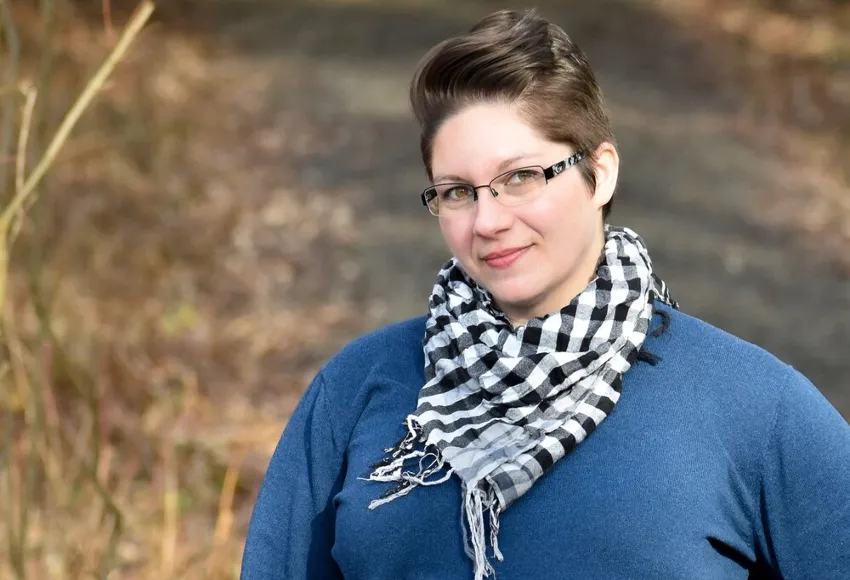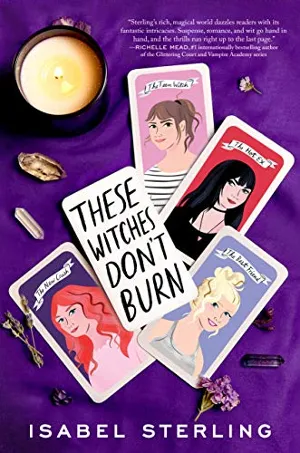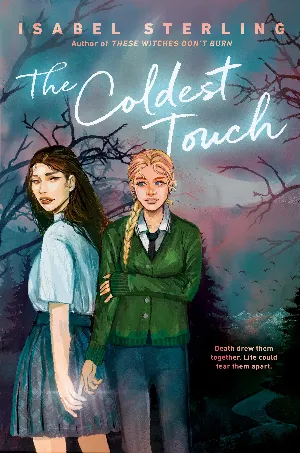For this week's book club, I picked up a copy of These Witches Don't Burn and prepared to enter one of the most frightening worlds imaginable–that of a teenage girl. The story centers around Hannah, a 17-year-old "Elemental Witch" living in Salem, Massachusetts. As if being a teen witch in the town known for its infamous witch trials weren't hard enough, the story begins with Hannah heartbroken after breaking up with her girlfriend. Worse yet, she fears they may both be in danger from a mysterious "Blood Witch."
After reading the book, I sat down with author Isabel Sterling to ask questions about her debut novel. While These Witches Don't Burn was her first published work, it certainly has not been her last. Since publishing her first novel in 2019, Sterling has released a sequel and prequel completing the series and is currently preparing for her next book, The Coldest Touch, to release in December.

Why write YA fiction?
A question burning in my mind was why write a story about teenagers? "I feel like I never 'graduated' to reading adult books," Sterling laughed. Aside from a love for the genre that pulled her into an obsession with books as a kid, Sterling has another connection to young adult literature: "I work right now with a lot of youth and teens, and I think it's such a vibrant age of life and I just love writing for that age group."
Sterling works as a coordinator for her local LGBTQ center in Oregon. She's seen firsthand what an impact Queer literature can have on young people. "Working at the LGBTQ center in my community and being around the Queer teens and seeing that even when they have supportive parents and even when they live in an area that has an LGBTQ center that they can come to, they still go through a lot."
She organized a book drive focused on works with LGBTQ representation, hoping to provide more resources for the teens. "To see teens come in and be really shy and then say 'Hey, do you like to read, what kind of stuff do you like to read?' and they'll be like 'Oh romance, oh sci-fi,' or whatever and then be able to say, 'Here are books like that, and every main character is like you,' and just to see their eyes light up. It is so important for them to see themselves in every kind of story."
Taking note of the importance of Queer representation, Sterling has set out to make sure her books contain accurate and happy portrayals of LGBTQ youth. "I always intend to write to Queer teens. I'm creating a space for them where they can come into this book and feel seen and heard. I am also very intentional about trying to find a balance of acknowledging the realities of the parts of their lives that are hard, but overall keeping the worlds in my book [accurate]."
She likes to create worlds teens will recognize, but she chooses to omit the worst parts of bigotry: "Say that our world right now is a 6 out of 10 in levels of acceptance, I try to keep my book worlds at like an 8, just bump it up a little bit without erasing the challenges that they have."
She keeps Queer readers at the forefront of her mind when creating her stories but also notes that her novels can be important to straight readers and allies alike. "I don't think there's anything about the books being so inherently Queer that pushes away straight readers either. I think they might miss some of the inside jokes, but I think it's still a very human story. I write to create a little pocket of happiness for my Queer readers, but I don't write to keep anybody out either."
A writer's journey
Sterling has always had a passion for creating. As a child she often stayed home from school sick, creating vivid stories on an old computer. "I would be home alone, and I would type this, like, kind of fan fiction, kind of like weird underground bunker fan fiction story, and I did that for like a year whenever I was home sick, then I forgot all about it, for like a decade." After finishing school and finding a job as a campus resident director, she found herself looking for a creative outlet. "I was just not doing anything creative. It was Halloween, and I was driving to my Grandma's to take my little cousins trick-or-treating, and I was like, 'It would be fun to write a book,' Then I found out about NaNoWriMo, and I just never stopped."
Taking part in the National Novel Writing Month, she created several rough drafts of stories. Writing began as a creative hobby and a journey of self-expression for Sterling. Eventually, she began the draft of what would become These Witches Don't Burn. "I am a relatively fast writer, so the first draft was a couple of months, then I took about a full six or seven months off, where I just didn't do any writing. I was mostly focused on just dating and falling in love." Revisiting the novel nearly a year later, she began revising. Within only a few months, she had found an agent.

These Witches Don't Burn underwent a grueling revision process before it finally came to be the novel it is today. "I initially thought it would be cool if it was a trilogy. I had it in my head that book one was going to be Hannah's point of view, book two was going to be, spoiler free, the Blood Witch's point of view, and then book three was going to be a Caster Witch's point of view, just so you could see all the different types of magic and stuff. Then when my publishers bought it they only wanted two books because trilogies have kind of fallen out of fashion."
Restructuring to just two books led Sterling to rewrite the sequel, This Coven Won't Break, four times before she was satisfied with the story. "I didn't know what to write for the story, but it ended up being such a better sort of overall story than I had even imagined initially."
Sterling admitted she was worried about how her publishers might handle Queer novels. "There was a lot of discussions back when my book was first coming out, back in 2017/2018 of, you know, 'Queer girl books don't sell,' and 'because everybody thinks that publishers don't market it.' I have been very happy with how the book has been promoted by my publisher, and they've been so great about promoting my new book coming out in December, and I don't think they've held any of that against me. I haven't had any pushback about going too far with any of my books."
A coming-out story
For Sterling, her first novel was more than just a creative outlet; it was also a way for her to start to understand herself more. "Hannah was always a Lesbian in the book, but at the time, I thought I was straight, so I was like, 'Who am I, this straight person, writing a Lesbian character?' At the time, there had already been some of the conversations coming up around 'own voices,' and I was like, 'Okay, I probably shouldn't.' I was having a lot of mixed feelings about it." However, when she tried to rewrite Hannah's character as straight, Sterling felt devastated. "I was like, 'Hmm, that's a little weird that I'm devastated about making this character straight?' By the time I finished the first draft, I had my own little like Queer awakening. I was like 'Oh, this is why I keep writing Queer characters, I'm Queer.' And then I sort of had to pause the book. I was like, 'I think I'm done writing. I think I was only ever writing because I needed to come out to myself.' I had been stuck on the revision and just decided not to do it. Then I met my now-wife, and we started dating. I went back to the book having lived my life as an out Queer person. I had completely changed how I revised it, and it became the book it is now."
Her wife ended up inspiring a character for the book. Sterling says with a laugh that she would never write herself into the book – "I would be way too boring to be one of my characters" – but she admits that the character of Morgan took some loose inspiration from her wife. "I do borrow interests and things like that. Like Morgan, she shares a lot of little facts with my spouse, like they're both from Minnesota, and have red hair, and did ballet in high school, so I will steal some of that stuff to help me round out a character, but no, I think if I was in one of my books, I would be hiding at home. I wouldn't be out solving mysteries because I'm a scaredy-pants."

What to expect in the future
Now that she understands what drew her to writing Queer characters, Sterling says she has no intention of stopping. "[My books] are all just getting more and more Queer, and my life is going that direction also." After releasing the sequel to These Witches Don't Burn and the prequel, titled This Spell Can't Last, she has decided to step away from Hannah's story and focus on a new set of characters.
Her new novel, The Coldest Touch, focuses on the character of Elise, a girl with a cursed power. "I started with just the idea of like, how awful would it be to have this ability? Whenever Elise touches somebody, she sees exactly how they are going to die, and she experiences the pain of their death. I was thinking, 'What a horrific power. What would that be like?' and my brain was spinning. How much more horrible would it be if you see it and you don't prevent it?" That's where the novel starts, and it only gets more supernatural from there! "When I was trying to think of who to pair up against Elise, she would need somebody that she could touch and not have that experience, and I was like, obviously, it has to be a vampire."
Fans of These Witches Don't Burn will surely be delighted by the style and magic of The Coldest Touch, but they can also expect to find something new from the author. "First of all, it is a dual point of view, so instead of being in one character's head, we're in two, which was a very fun challenge," says Sterling. "I think it is a bigger paranormal world we're going to see. There are also more relationship dynamics." In her new book, she tackles aspects of Queer identity not addressed in her last novels. "In These Witches Don't Burn, all of the characters that we run into for the most part are already out. Like the opening scene is of Hannah summarizing her very undramatic coming out experience, and one of the biggest differences in The Coldest Touch is Claire, the vampire, she knows that she is a Lesbian, and she does not doubt that, but the main character Elise, who is the death oracle, she shares a little bit more of my personal experience, feeling very supportive of the community, having dated guys, and just being completely oblivious to the fact that she is Bisexual, which she discovers throughout the book. I think that is going to be new in terms of representation."
She hopes to continue writing paranormal Queer stories, "I don't know if I'll be allowed to, but my dream is to go through and tackle all of the different paranormal creatures of my childhood that I loved. Right now, I'm working on something with ghosty kind of stuff. Who knows where that will turn out because it's just in a first draft. But I also have a couple of ideas for a werewolf book. I would love to just do them all."
When it comes to witches, Sterling says she sees a link to Queer experiences. "I think with the LGBTQ community, at least with the folks I know, a lot of the community I work with are into paganism and they find a lot of solace with the whole ethos of the witch and sort of being an outcast in terms of society but also having this strong internal power. I think that speaks a lot to the LGBTQ community."
Her novels These Witches Don't Burn and This Coven Won't Break are available now, wherever you get your books.

